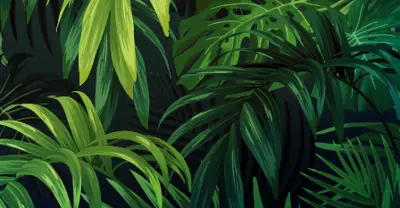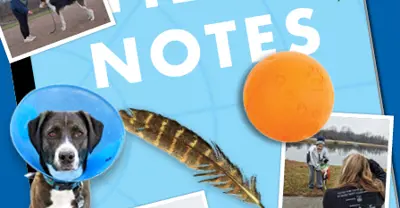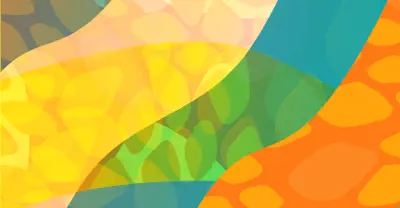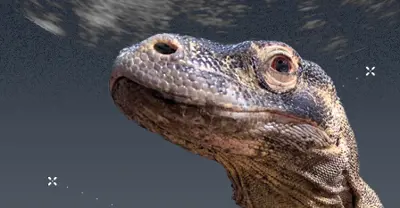Bird Box: The USI Story of the Fall and Rise of Eastern Bluebirds
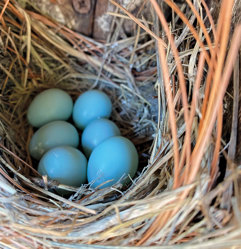 The story of USI's Bluebird Trail project and the ornithological research of those blue feathered friends begins more than 150 years ago when Bernhard Nurrenbern and John Henry Steinkamp took chance and bought 160 acres—sight unseen—for $1.62 per acre. Land that would eventually be donated by Mary Nurrenbern, the great-granddaughter of Bernhard Nurrenbern to Southern Indiana Higher Education, Inc. (SIHE) on which to build today's University. Originally a conservation effort to save the songbirds in the 1970s, the project evolved into a long-term study of how climate and environmental problems affect nature.
The story of USI's Bluebird Trail project and the ornithological research of those blue feathered friends begins more than 150 years ago when Bernhard Nurrenbern and John Henry Steinkamp took chance and bought 160 acres—sight unseen—for $1.62 per acre. Land that would eventually be donated by Mary Nurrenbern, the great-granddaughter of Bernhard Nurrenbern to Southern Indiana Higher Education, Inc. (SIHE) on which to build today's University. Originally a conservation effort to save the songbirds in the 1970s, the project evolved into a long-term study of how climate and environmental problems affect nature.
Before the Research
Nurrenbern and Steinkamp were part of more than a million immigrants who fled Germany to the United States in the 1830s to escape economic hardship. When the families arrived in Evansville by paddle boat from Cincinnati, Ohio, they discovered a town boasting 36 houses, a cemetery, two churches and a small main street with thriving businesses, including a newspaper and mail services. Penniless (having been robbed of their savings on the paddle boat), they learned the land they had purchased to farm was a densely populated hardwood forest of Cypress and White Oak trees. The families felled the trees and sold the wood to pay for supplies needed to make their dream of owning and farming their land come true. Subsisting on the wild boar and bear that roamed the thick forests, they prospered, leaving a farmstead legacy more than tenfold their original purchase.
Birth of the Birdboxes
By the spring of 1966, as the first University buildings went up on Nurrenbern land, the bears and boars that once roamed the woods were long gone; white-tailed deer, wild turkeys, rabbits and an amazing diversity of birds now filled the woods. When Dr. Alton Lindsey, a pioneering ecologist and one of the scientists on the 1928-30 Byrd Antartica Expedition, visited the campus he walked the acreage and concluded the University had the greatest botanical diversity of any campus he had visited, except, perhaps, the Redlands Campus in California. A former professor of then Dean David L. Rice, who later became USI’s first president, Lindsey warned Rice he would "retroactively flunk" him if he didn't manage the property carefully.
That same spring, Rice presented an "inspirational slide show" about the University to the Westwood Garden Club that included future needs and hopes for a nature center. This piqued Club members' interest, and Doris Eicher, who grew up encouraged to love the outdoors, envisioned a trail system that would connect with Burdette Park. The Club approached Rice about creating trails for the students and community in the wooded areas surrounding campus. Given the green light, the women of the Club enlisted Boy Scout Troop 371 to carve our 5.5 miles of wooded trails that wove around the campus' bluffs and creek beds. 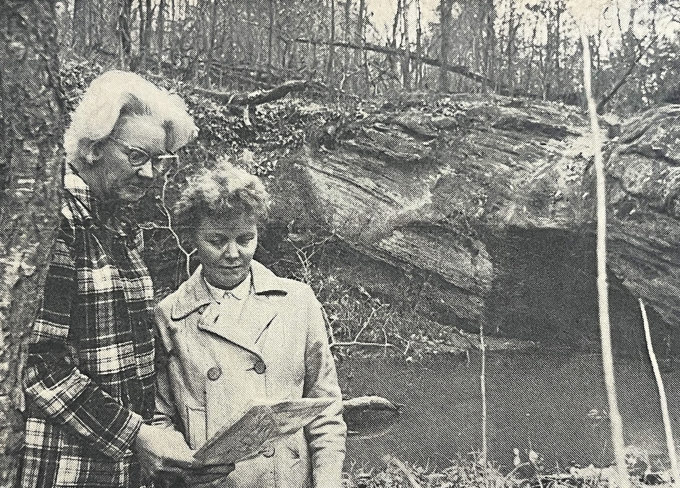
Many members of the Westwood Garden Club participated in the Audubon Society's annual Great American BirdCount, counting birds they spotted from their yards. Helen and Richard Buck and the Eicher family counted birds on the University's campus as well. Both families delighted in having bluebird houses on their property to hear their expressive range of sounds, from plaintive to scolding to warbling.
In 1972, however, the woods no longer rang with the birds' unique songs, and bird counters noted in their reports that the local eastern bluebird count had sharply declined. The reason: unusually harsh winters and loss of habitat attributed to rapid urban development on Evansville's west side. If the birds were to survive and thrive in the region, they would need their own "urban development."
Banking on their friendship with Rice, himself a bird enthusiast, Helen Buck and Doris Eicher sent a letter proposing building bluebird houses on the trail the Boy Scouts created, noting the "bluebirds prefer to nest in holes in wooden fence posts or in cavities in older trees. Authorities agree that boxes built to specification and mounted about fence-post height on the edge of timber or underbrush will attract and encourage the bluebirds to nest. We would be grateful for your permission to proceed with the Bluebird Trail."
Rice loved the idea and instructed the Club to meet with Paul Grimes, the University's Superintendent of Buildings and Ground, to determine their location on the trail, with the understanding that if the campus grew, the trail would have to be relocated.
Members of the Westwood Garden Club and Audubon Society of Evansville met to put together 22 bluebird houses with donated wood. Virgil Eicher and Richard Buck put the houses up on the trail and everyone waited to see what would happen. The Club knew bluebirds can lay eggs up to three times a year, if the conditions are right.
The first year, the boxes contained 11 baby bluebirds. Buoyed by their success, the Garden Club members spent the rest of the year learning as much as they could about the identification, migration habits, feeding and horticultural needs of birds. Their trail logs described a doe stepping out of the thicket between boxes six and seven, a Camomile in bloom, a groundhog den and a variety of snakes and turtles laying eggs by Reflection Lake. But they also noted a deadly competitor: the house sparrow. They were taking over the bluebirds' nesting boxes.
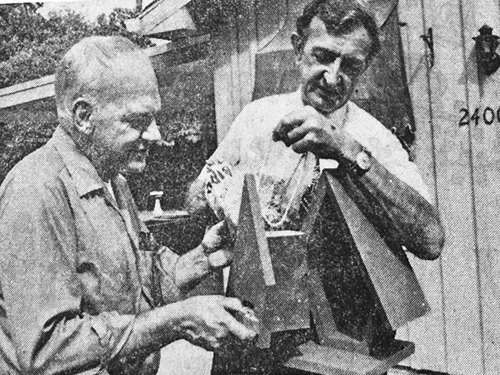 The invasive nonnative sparrows were introduced in the United States in the mid- 1850s as a means of controlling the caterpillar population that were destroying Basswood trees. By the 1970s their population had exploded, and the aggressive little birds were taking over the nesting sites of native birds such as purple martin, tree swallows, chickadee and eastern bluebirds. They harassed, attacked and killed those native birds and destroyed the eggs in the nests they invaded.
The invasive nonnative sparrows were introduced in the United States in the mid- 1850s as a means of controlling the caterpillar population that were destroying Basswood trees. By the 1970s their population had exploded, and the aggressive little birds were taking over the nesting sites of native birds such as purple martin, tree swallows, chickadee and eastern bluebirds. They harassed, attacked and killed those native birds and destroyed the eggs in the nests they invaded.
To stop the carnage, the Garden Club members altered their bluebird box design and began removing the sparrows' nests found in bluebird boxes. They also plugged the holes as soon as the bluebirds finished nesting to prevent other birds from using them.
The Buck and Eicher families began speaking to local groups, churches and schools about the observations on USI's trails and their conservation efforts on behalf of the eastern bluebird. Donations poured in. The Eichers put many miles on their car, as their love for the bluebirds took them to Illinois and Kentucky. It was a family affair until 1977 when Virgil Eicher died following open-heart surgery. Soon after that, there was an unexplained absence of bluebirds noted in the field logs. The records show no bluebirds visited the Bluebird Trail boxes from 1978-1981.
Evolution of Research
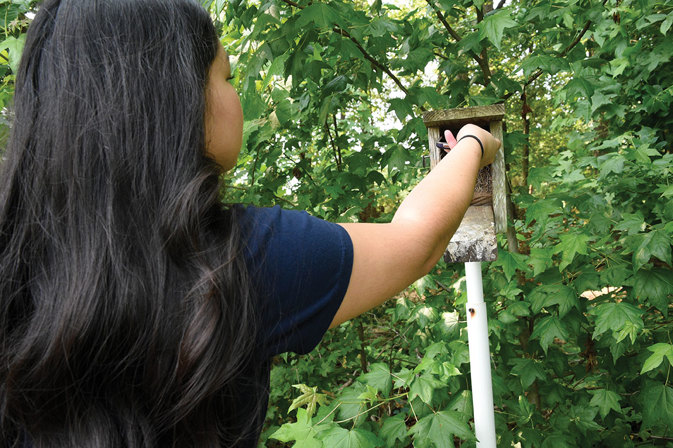 By the 1990s, the original members of the Garden Club were no longer monitoring the Bluebird Trail's boxes, but Dr. Chuck Price, Professor Emeritus of Teacher Education, had taken an interest. Like the Bucks and Eichers, Price found great satisfaction taking photos of nature and came across the bluebird boxes that had fallen into disrepair and set out to revive the project. He took his science education students out on the trail to give them an example of bringing the outdoors to the classroom, inserted a small camera into one of the birdboxes and wrote a grant to support the monitoring of the birdboxes by USI students.
By the 1990s, the original members of the Garden Club were no longer monitoring the Bluebird Trail's boxes, but Dr. Chuck Price, Professor Emeritus of Teacher Education, had taken an interest. Like the Bucks and Eichers, Price found great satisfaction taking photos of nature and came across the bluebird boxes that had fallen into disrepair and set out to revive the project. He took his science education students out on the trail to give them an example of bringing the outdoors to the classroom, inserted a small camera into one of the birdboxes and wrote a grant to support the monitoring of the birdboxes by USI students.
Along with Don Fleming, Property Supervisor and Services Coordinator, Price established 50 new birdboxes in the grasslands surrounding campus, igniting a new wave of bluebird study involving USI students from across disciplines.
After Price retired, Dr. Jim Bandoli, Professor Emeritus of Biology, took over. As campus grew so did the threat to the bluebird population and other natural wildlife. As a researcher in wildlife biology, Bandoli knew the conservation of campus wildlife was important to future research by biology students and faculty. He recruited students from his wildlife biology class to monitor and record bluebird activity. Most of the students weren't going to be wildlife conservationists or park rangers, but they all loved being outdoors.
The birdbox research took a turn when Dr. Alex Champagne, Associate Professor of Biology, took over when Bandoli retired in 2017. Champagne's team of students collected information to evaluate habitat preference of nesting birds, observe yearly fluctuations in species composition and study the impact of climate change on the timing of breeding. If the summers are too hot and dry, do the birds go elsewhere? Do they lay fewer eggs because there is not enough food supply for the bluebirds?
The research has revealed the eastern bluebirds now lay their eggs approximately 12 days earlier than their predecessors in the 1970s, indicating the bluebirds are adjusting and responding to increasingly warmer temperatures. Other things have changed too. Unlike their predecessors, who recorded the data in physical field logs, today's birdbox monitors enter their data into Google Sheets via smart phones.
Legacy, however, endures—whether it's the Nurrenbern and Steinkamp families who still farm on this side of town or the progress afforded campus thanks to the donations made by Mary Nurrenbern, and others, 60 years ago. Even the work of the Westwood Garden Club lives on, as another generation of USI faculty and students take to the trails, checking bluebird boxes to help research and understand how commercial expansion and residential growth not only impact bluebirds but us as well.

Thanks to USI Archives, Bobbie Steinkamp Richardson, Charles Steinkamp, Willard Library, Dr. Chuck Price, Dr. Jim Bandoli, Dr. Alex Champagne, Jessica Yorgenson, Kaitlyn Knox, Sue Vernier, Roberta Heiman's A Story of Leadership: Southern Indiana Higher Education, Inc., USI Foundation, Richard and Helen Buck, Virgil and Doris Eicher, the Westwood Garden Club and the National Audubon Society for contributions to this story.
Author Bio:
Barbara Goodwin is a Visual Content Specialist who has worked at USI for 26+ years, 24 of them in Photography and Multimedia. She has a degree in Communications and is a nature enthusiast. She worked with the University in 2023 to re-establish the original 1969 trail system through the woods surrounding USI. You can find her most days photographing two of her favorite things at USI: the students and the trails. Follow her photography of USI trails on Instagram @USI_Trails.

